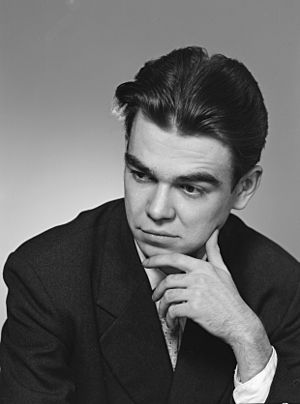Pentti Saarikoski facts for kids
Pentti Saarikoski (born in Impilahti, now in the Republic of Karelia, on September 2, 1937 – died in Joensuu on August 24, 1983) was one of the most important poets in Finland during the 1960s and 1970s. He wrote many poems and also translated famous books. Some of his well-known translations include Odyssey by Homer and Ulysses by James Joyce.
Saarikoski once said he was the only person to have translated both Homer's and Joyce's Ulysses. This is probably still true today! He translated Homer's Odyssey in just two years, which was very fast. He also translated other important books like Poetics by Aristotle and Catcher in the Rye by J.D. Salinger.
Pentti Saarikoski is buried in Heinävesi at the cemetery of the New Valamo monastery.
Contents
Early Life
During World War II, Pentti Saarikoski was sent to Sweden as one of the Finnish war children. He learned to read and write Swedish in Norrköping in 1944.
His Creative Work
Saarikoski became very well-known with his book of poems called Mitä tapahtuu todella? (What is actually going on?). It was published in 1962. This book started a new style of poetry in Finland called "participative poetry." This meant that poets should use their writing to get involved in politics. Some poems in this book clearly had political messages. Before this, many Finnish poets thought art should only be for art's sake.
Mitä tapahtuu todella? also showed a change in Saarikoski's writing style. His first books, Runoja (Poems) and Toisia Runoja (Other Poems), both from 1958, were different. They often mentioned ancient Greece. Because of this, critics called his early work his "Greek period." Saarikoski was interested in Greek culture from a young age. He even studied Greek and literature at the University of Helsinki in the 1950s, but he did not finish his degree.
During the 1970s, Saarikoski kept publishing poem collections. He greatly admired the Greek philosopher Heraclitus. Saarikoski even used Heraclitus's nickname, "The Obscure," in his poetry. He started to make his poems intentionally harder to understand. One of his collections was titled Hämärän Tanssit (The Dark One's Dances), which refers to Heraclitus.
Even though some of his works from the late 1960s were not very popular with critics, his last three poem collections are seen as another high point in his career. These three books are known as the "Tiarnia-trilogy" (1977, 1980, 1983). He wrote them in Sweden, where he lived with his last wife, Mia Berner. These works show his concern about a society that relies too much on technology and rules. He felt this kind of society stopped people from taking part in community life. All these books have the word "dance" in their titles, which means a way of showing social resistance.
Saarikoski also wrote regular articles, called columns, using the pen-name "Nenä" ("Nose"). In his columns, he cleverly made fun of the church, the army, politics, and old-fashioned ideas. He was very good at making fun of the special language used by politicians at the time. He also worked as the main editor for Aikalainen, a cultural magazine connected to the Communist Party of Finland, from 1963 to 1967.
His Political Involvement
Pentti Saarikoski was a candidate for a political group called the Finnish People's Democratic League (SKDL) in the elections of 1966 and 1970. However, he was not elected to the parliament. He became a member of the Communist Party of Finland in 1968.
A Public Figure
Saarikoski was a very well-known celebrity in Finland. He was a strong supporter of communism and was married four times. Saarikoski once said: "I make my life fiction so that it would be true." His daughter, Helena Saarikoski, said that her father was a great example of a European bohemian. A bohemian is someone who lives an unconventional life, often involved in art. She felt he helped create the image of a modern intellectual person in Finland.
Translated Works
- Helsinki: selected poems of Pentti Saarikoski; translated from Finnish by Anselm Hollo (London: Rapp & Carroll, 1967)
- Poems: 1958-1980; translated from Finnish by Anselm Hollo (West Branch, Iowa: Toothpaste Press, 1983)
- Trilogy (The dance floor on the mountain, Invitation to the dance, The dark one's dances); translated from Finnish by Anselm Hollo (Albuquerque: La Alamada Press, 2003)
- The edge of Europe a kinetic image by Pentti Saarikoski; translated from Finnish by Anselm Hollo (University of Notre Dame, Indiana: Action Books, 2007)
See also
 In Spanish: Pentti Saarikoski para niños
In Spanish: Pentti Saarikoski para niños



